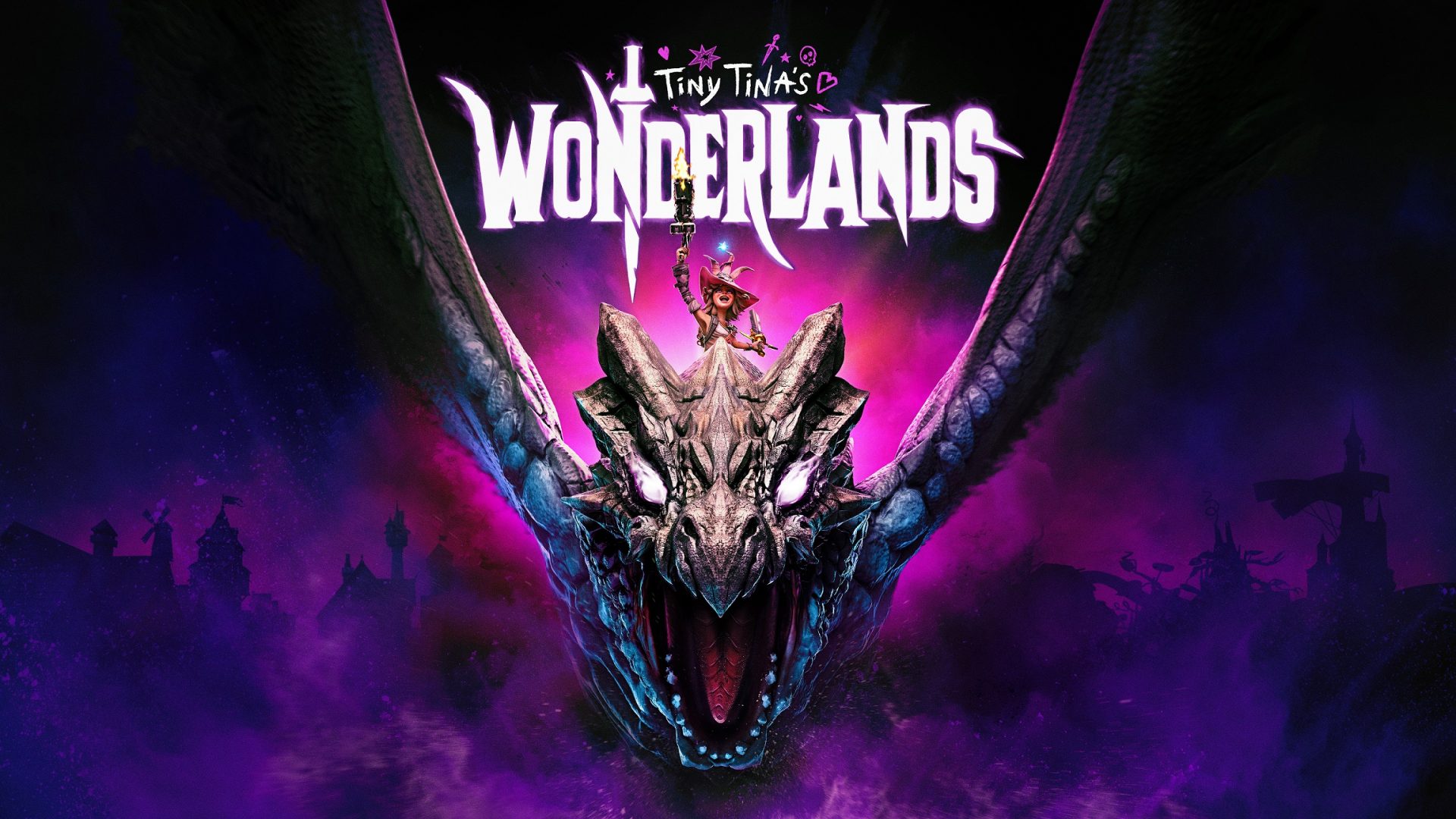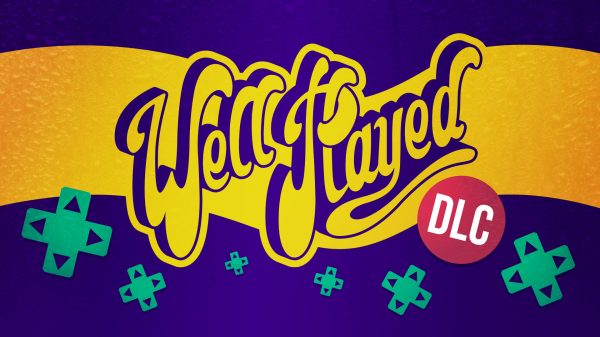Spin-off titles are a tricky thing. Obviously, there needs to be a certain level of familiarity involved, otherwise, it may as well be an entirely new game, but if played too safe it can come across as pointless and derivative. Taking a glass half empty approach, Tiny Tina’s Wonderlands might initially look like nothing more than a Borderlands with pointy ears and references to dice, a viewpoint that even I flirted with in my preview of the game. Scratch the surface though, and Wonderlands stands out as more of a successor than a side note, eclipsing that which came before it with interesting new gameplay systems and writing that doubles down on the wit the series is known for and avoiding some of the more wince-inducing gags the series is also known for.
Anyway, that’s enough of that, let’s roll some dice, fire some guns and kick some arse.
First introduced in Borderlands 2, Wonderlands takes place completely within a game of Bunkers and Badasses, a tabletop role-playing game that bears more than a passing resemblance to a certain real-world RPG. You play as the Fatemaker, a newly created character who’s joining the table as they start a new campaign to defeat the evil Dragon Lord. You can’t just use a plain, unpainted mini though, so you’ll need to create your hero in a series-first character creator. There are plenty of options at your fingertips as well, including plenty of fantasy race features and silly colours, so you can go nuts. I landed on a mighty elven mage dubbed Vacuumous, a name that’s sure to strike fear into anyone on the wrong end of my spells.
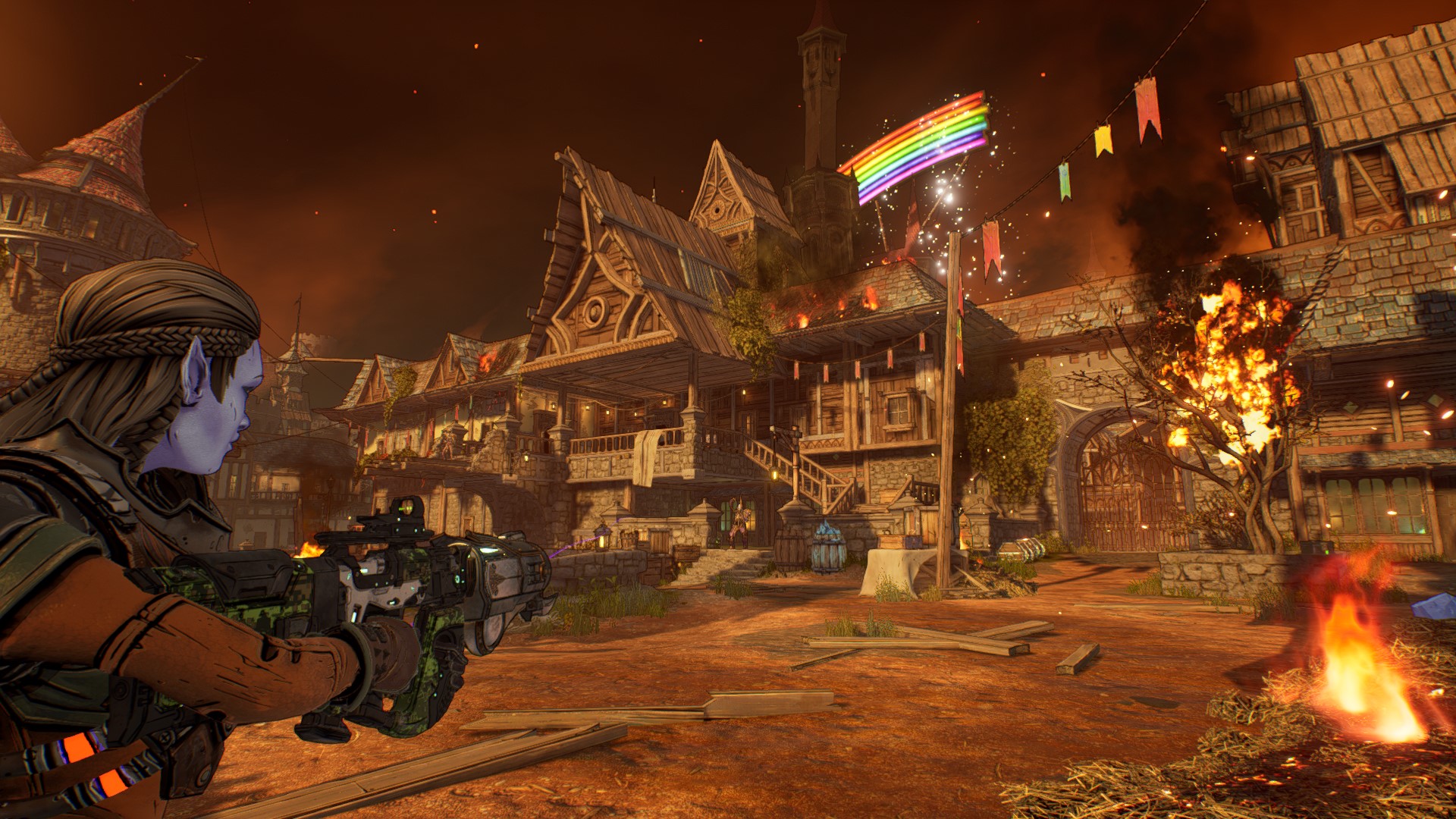
Look at the bright side, there’s a nice rainbow above all of that the destruction
Looks aren’t everything, of course, you’ll need to fill out your character sheet before you start rolling dice. Wonderlands offers up six playable classes: The Stabbomancer, Brr-Zerker, Spellshot, Clawbringer, Spore Warden and Graveborn. Each comes with its own skill trees, abilities and perks, and all of them feel unique and offer up a different way to play. For instance, the Graveborn is a damage dealer that specialises in devastating area-of-effect attacks that also drains their health, whereas the Clawbringer is a tank that wields a throwable hammer and is accompanied by a little dragon friend that breathes fire on your enemies.
Each class has two primary abilities to choose from that can be unlocked as you play. I started the game as a Spellshot that could polymorph enemies into harmless, flying sheep for a few seconds, before unlocking the secondary ability to dual-wield spells. While levelling you’ll allocate skill points into both skills and traits. Skills will provide buffs and modifiers to your abilities, and traits will raise your overall stats such as health and spell cooldown. The progression is satisfying as your character levels up quickly and your skillset evolves and grows, before expanding massively into all sorts of wild territory.
Just as you’ve got a handle on your current spread of abilities, you’ll be given the option to multiclass. Selecting from one of the five remaining classes, you’ll have full access to that skill tree alongside your original one. You can still only have one major ability active at any given time, but you’re able to swap that out at will, giving you heaps of variety in how you’d like to play. Once the main story wraps up, you’re even given the option to completely respec your character and change your secondary class whenever you like, so you can experiment with everything without needing to commit to a second playthrough. It’s a great amount of freedom and variety that keeps encounters feeling fresh and fun.
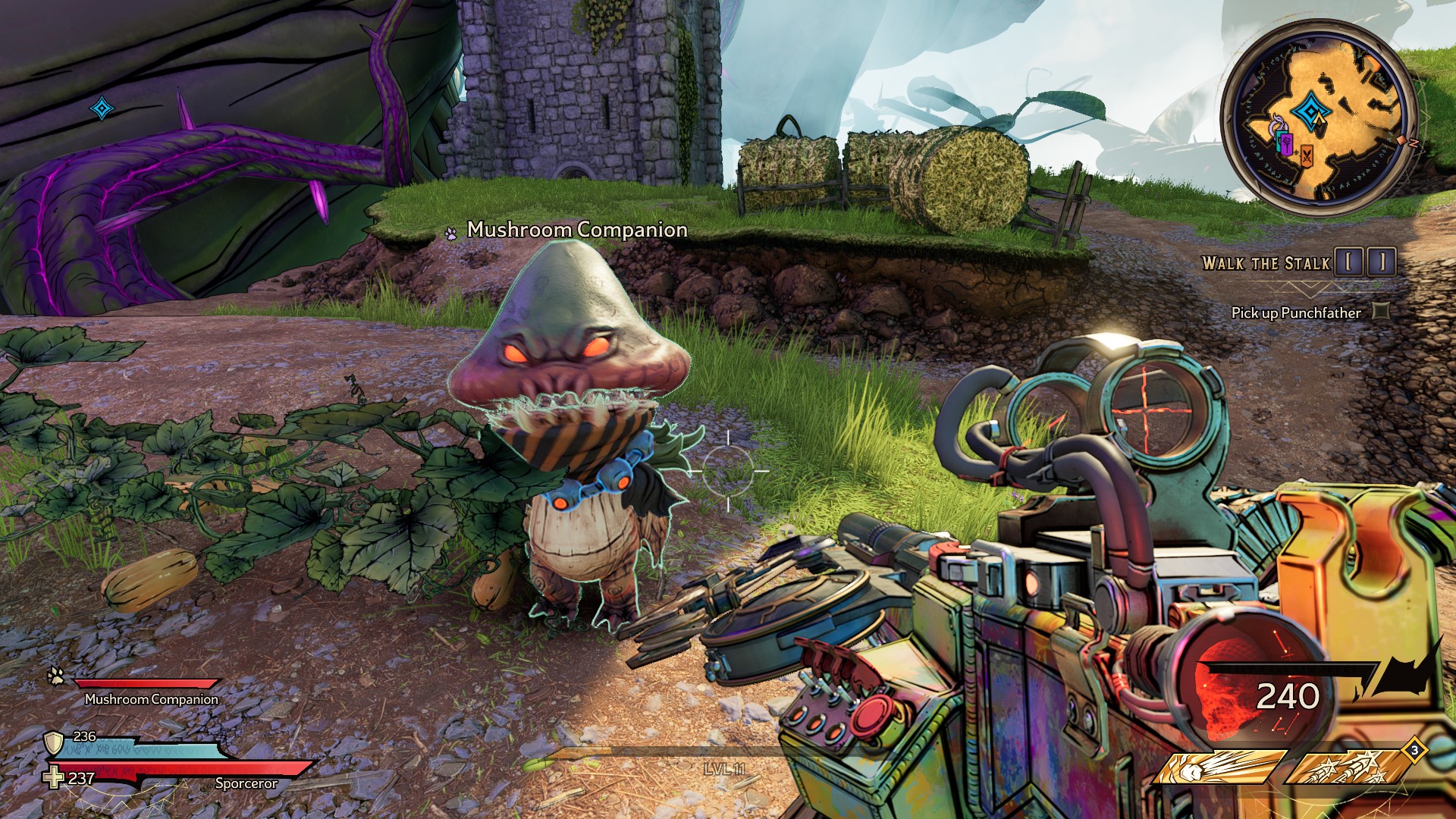
My little mushroom friend is the best and I love him
Ok, time to talk about the guns. Yes, this is a fantasy world, but it’s a fantasy world within the Borderlands universe, so of course, there are going to be guns. All of the typical archetypes are here – assault rifles, pistols, shotguns, sniper rifles and the like – but they’re all given a magical makeover; magic runes revolve around barrels, crossbow mechanisms are mounted to pistol grips and modern metal is replaced with ye ol’ wood. Outside of the entertaining visual overhaul, the weapons also take on magical traits, with your typical SMG spewing out a stream of arcane energy rather than a hail of bullets, and sniper rifles launch magic bolts instead of your typical rounds. Elemental effects such as caustic and fire return, each being effective against a certain enemy type, and so too does the secondary fire option introduced in Borderlands 3, so if you’re familiar with the gunplay from the previous games you’ll feel right at home. I will say though, I do wish that the more exciting loot either dropped a little more often or began appearing a little earlier on, as I feel like many of the chests I opened stayed unlooted and my loadout remained unchanged for large periods.
Being the Fatemaker, you’re also capable of casting spells. Found in the loot pool, these mystical attacks can be cast while firing your weapon to either deal damage, cause a status effect on the enemy, or buff yourself and your teammates. While these do act as the game’s alternative to grenades, I found the spellcasting to be far more interesting and gratifying to use in comparison. Tied to a generously short cooldown, spells quickly become an integral part of combat that change as often as your weapons do. Standouts from my playthrough include a binding spell that drew in enemies before dropping a meteor on their head and a life-draining blast that more or less turned me into a gun-toting elven vampire.
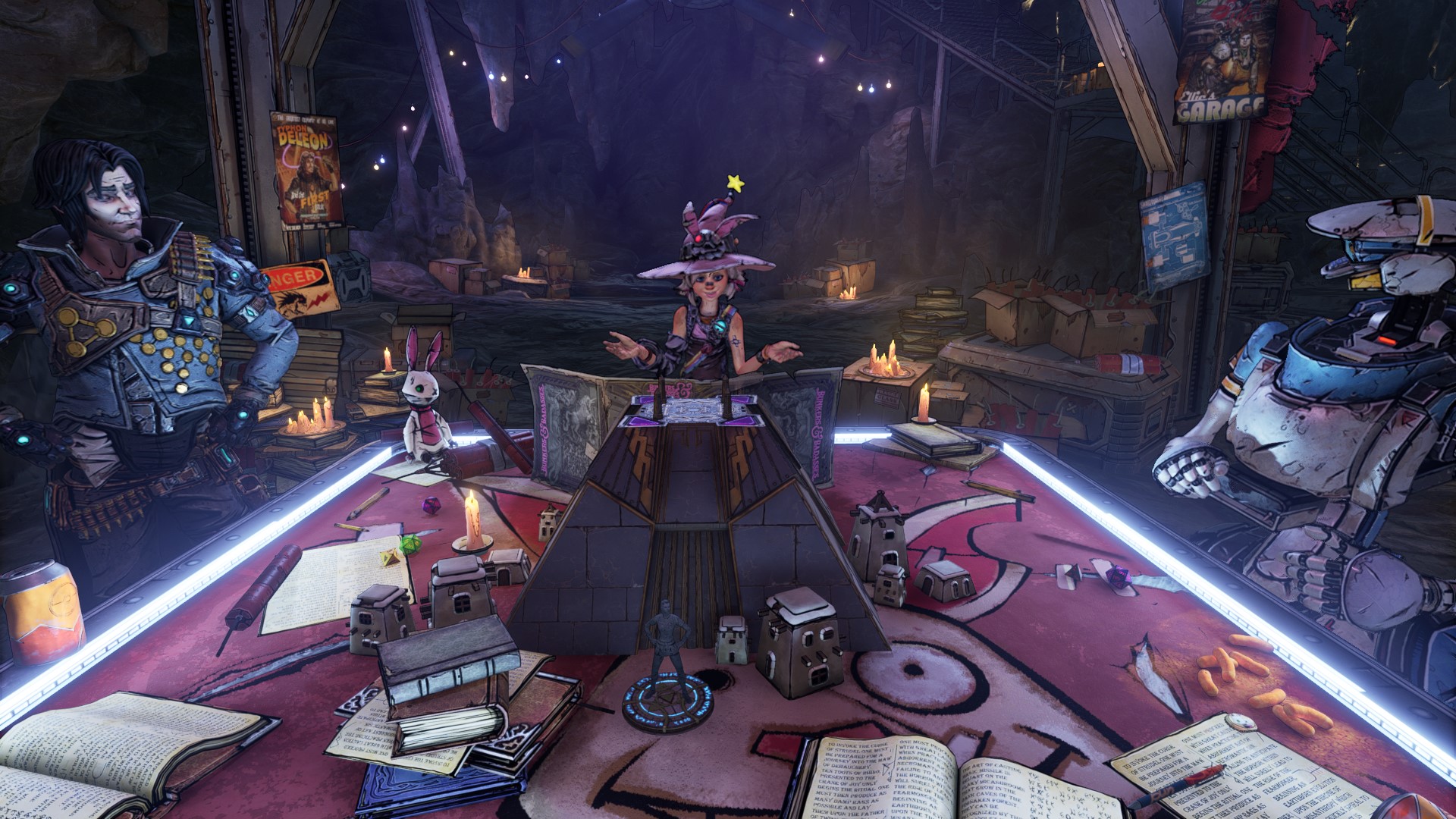
Nothing like rolling some dice with your friends
Overall, the combat in Wonderlands iterates on the Borderlands formula without changing the fundamentals too drastically. The multiclass options, fun abilities, varied and useful spells and wide weapon selection makes Wonderlands’ minute-to-minute gameplay an absolute blast and solidifies it as the most mechanically interesting game in the series.
On your quest to defeat the Dragon Lord, you’ll travel between several diverse locations, each with its own look and feel. Starting in your typical high-fantasy village filled with rolling hills, your party will traverse dunes dotted with tropical oases, snow-capped mountain ranges riddled with caves and underwater depths to name a few. Looking back at the original’s one-note wasteland environments, it’s clear to see just how far Gearbox has come. Each of the different locations comes with its own cast of enemies too, like serpentine warriors, droves of undead skeleton pirates and of course, dragons.
Between these main areas is the Overworld, which is in fact the table that the game is being played on. When moving from one area to the next, your character will take the form of a miniature, albeit with a comically large head. From here you can explore the map and discover side quests and other hidden secrets. Weirdly enough, you can also run into random encounters in tall grass as though you were a teenager setting out to trap animals in balls to force them to fight. Sure, you can melee these enemies and ignore them, but if they touch you, you’ll be drawn into an encounter and forced to clear out several goons in one of a few generic areas depending on where you are on the map. Though they’re not that intrusive, this doesn’t add anything to the experience and can be annoying when you’re just trying to get from A to B.
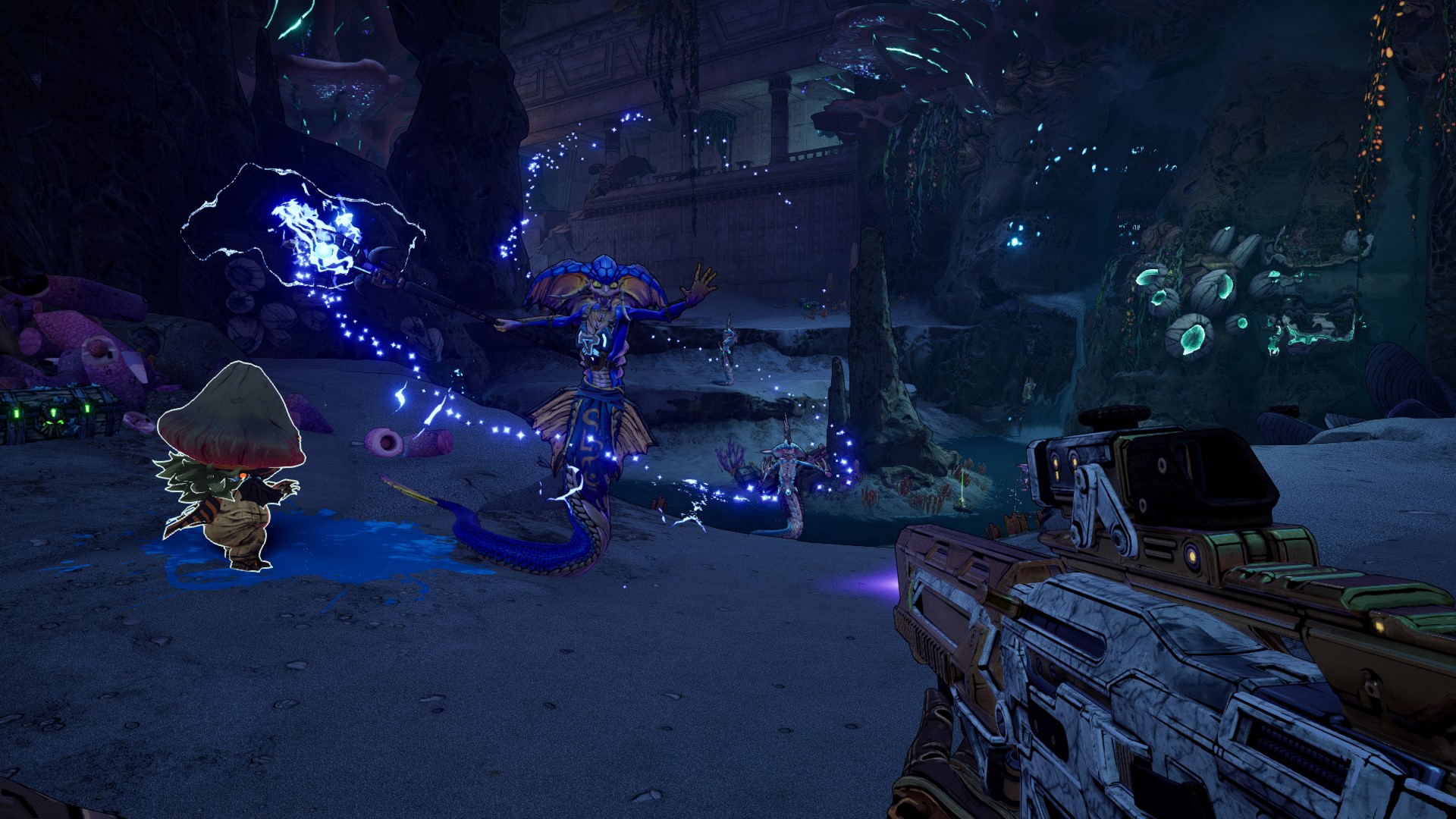
Hmm, that snake lady doesn’t like my little mushroom man, must be a villain
The game’s side content is a bit of a mixed bag as well. Each biome has at least one optional area that contains a major side quest, complete with a story, bosses and objectives, and these are all entertaining and engaging. Outside of that, lesser side missions are all rinse-and-repeat affairs that task you with clearing two or three rooms, retrieving a McGuffin and returning to the quest giver. Luckily, these can be ignored for the most part, as the larger side quests will give you enough experience to advance the main story without getting your teeth kicked in by enemies more powerful than you.
Like any good game of D&D, I mean, Bunkers and Badasses, the story takes twists and turns along the way. The writing in the Borderlands games has always been a bit divisive, toeing the line between cringy and funny, but Wonderlands steps firmly into the latter. Leaning into the meta situation of a video game character playing a tabletop character, you’ll constantly be getting commentary on the situation from the Bunker Master herself, Tiny, as well as your two fellow players, Valentine and Frette. Table conversations also affect the game itself, with a catapult being rebuilt following its destruction because the table decided it would be cooler to use it, or a drawbridge being lowered because you managed to successfully romance it. It’s all over-the-top and silly, but it feels like the quirky humour has finally managed to find the right balance here. Oh, and I heard a skeleton enemy yell out “call a cleric, but not for me,” so top marks all around.
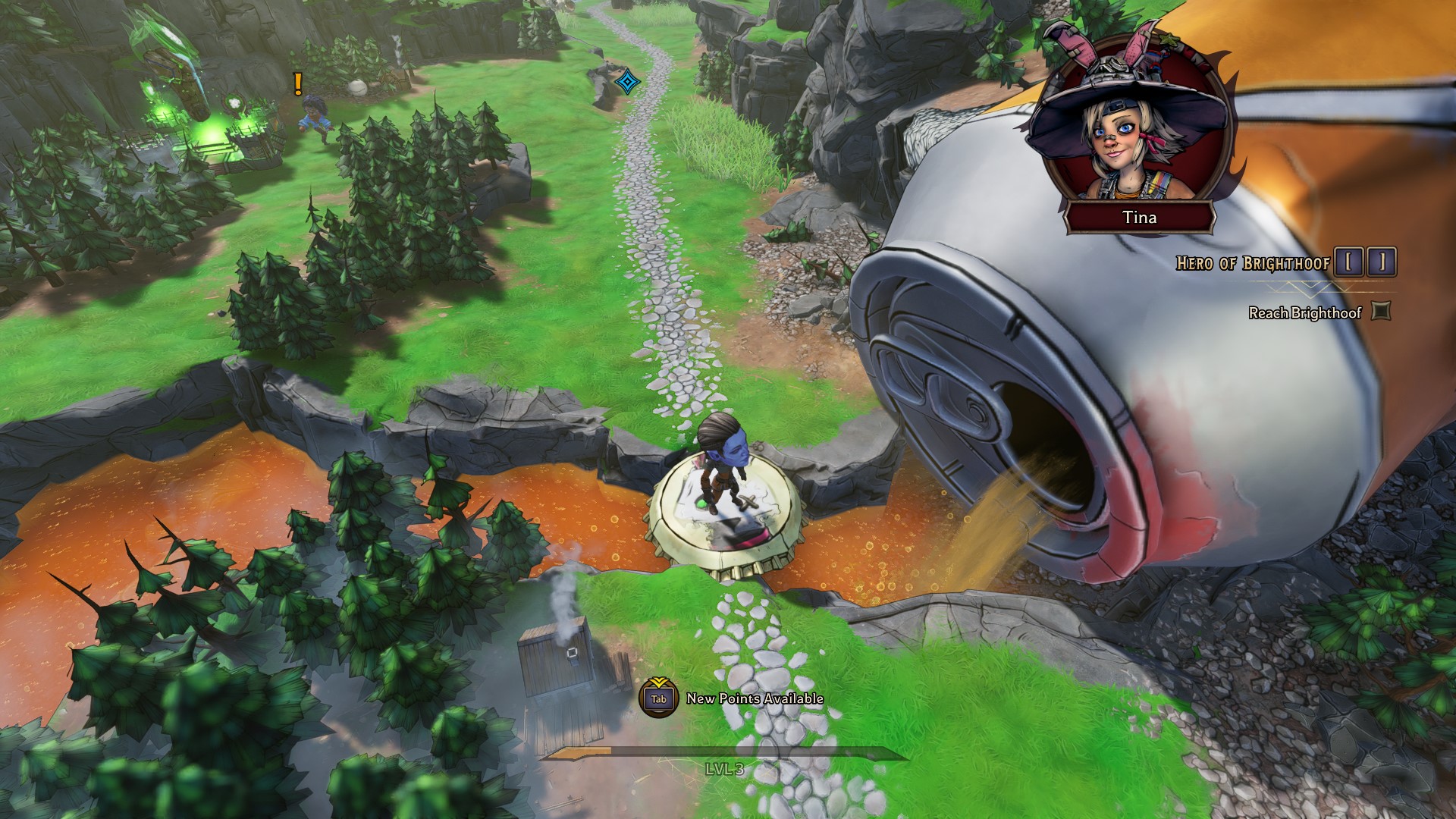
Some say the source of the river came from space, others say it’s just a can of soda. We’ll never know for sure
The main narrative is fun and entertaining largely thanks to Wonderlands’ incredible voice acting. Ashly Burch reprises her role as Tiny Tina, which will either excite or annoy you, while Wanda Sykes portrays Frette, the rule-loving robot, and Andy Samberg plays the dim and awkwardly charming Valentine. Both supporting players have huge personalities and are endlessly endearing, with some brilliant voice lines shared between them. The standout, however, is Will Arnett’s Dragon Lord. Similar to Handsome Jack, the Dragon Lord is in your ear throughout your journey, providing laughs and grins the entire time. Whether he’s berating you or just throwing out exposition, it doesn’t matter, it’s always great.
Lastly, once you finish the 15ish-hour main campaign, you’ll gain access to the Chaos Chamber, a replayable endgame mode that randomises rooms and enemies while upping the difficulty. Moon Orbs, a currency specific to this mode, can be earned and spent on buffs that will help you clear rooms, while curses can be applied at the end of each room to raise the difficulty while also increasing the chance of better loot dropping. This mode certainly won’t keep you coming back for months on end, but it does provide you with a significant challenge and a means to continue hoovering up loot.
Final Thoughts
Wonderlands could easily have been a rehash of the Tiny Tina’s Assault on Dragon Keep expansion for Borderlands 2, but it’s decidedly more than that. While maintaining the core concepts of what made the Borderlands series so popular, Wonderlands fine-tunes certain mechanics while introducing others to provide a varied and consistently entertaining experience that bests its predecessors. Some weird gameplay choices and middling side content aside, Wonderlands’ varied combat options, excellent voice acting and genuinely humorous narrative culminates in a spin-off that outshines and outclasses the original.
Reviewed on PC // Review code supplied by publisher
Click here for more information on WellPlayed’s review policy and ethics

- Gearbox Software
- 2K Games
- PS5 / PS4 / Xbox Series X|S / Xbox One / PC
- March 25, 2022



Adam's undying love for all things PlayStation can only be rivalled by his obsession with vacuuming. Whether it's a Dyson or a DualShock in hand you can guarantee he has a passion for it. PSN: TheVacuumVandal XBL: VacuumVandal Steam: TheVacuumVandal





